Attached files
| file | filename |
|---|---|
| 8-K - FORM 8-K - Approach Resources Inc | d76830e8vk.htm |
Exhibit 99.1

| Company Presentation October 12, 2010 |

| October 12, 2010 Slide 2 Forward-looking statements and cautionary statements This presentation contains forward-looking statements within the meaning of Section 27A of the Securities Act of 1933 and Section 21E of the Securities Exchange Act of 1934. All statements, other than statements of historical facts, included in this presentation that address activities, events or developments that the Company expects, believes or anticipates will or may occur in the future are forward-looking statements. Without limiting the generality of the foregoing, forward-looking statements contained in this presentation specifically include the expectations of management regarding plans, strategies, objectives, anticipated financial and operating results of the Company, including as to the Company's drilling program, estimated reserves and drilling locations, hedging activities, capital expenditures, financial and operating guidance, potential value added by processing NGLs, typical well results and future production included in the presentation. These statements are based on certain assumptions made by the Company based on management's experience and perception of historical trends, current conditions, anticipated future developments and other factors believed to be appropriate and believed to be reasonable by management. When used in this presentation, the words "will," "potential," "believe," "intend," "expect," "may," "should," "anticipate," "could," "estimate," "plan," "predict," "project" or their negatives, other similar expressions or the statements that include those words, are intended to identify forward-looking statements, although not all forward-looking statements contain such identifying words. Such statements are subject to a number of assumptions, risks and uncertainties, many of which are beyond the control of the Company, which may cause actual results to differ materially from those implied or expressed by the forward-looking statements. In particular, careful consideration should be given to the cautionary statements and risk factors described in the Company's Annual Report on Form 10-K filed with the Securities and Exchange Commission ("SEC") on March 12, 2010. Any forward-looking statement speaks only as of the date on which such statement is made and the Company undertakes no obligation to correct or update any forward-looking statement, whether as a result of new information, future events or otherwise, except as required by applicable law. The SEC permits oil and gas companies, in their filings with the SEC, to disclose only proved, probable and possible reserves that meet the SEC's definitions for such terms, and price and cost sensitivities for such reserves, and prohibits disclosure of resources that do not constitute such reserves. The Company uses the terms "estimated ultimate recovery," "EUR," reserve "potential," "upside" or other descriptions of volumes of reserves potentially recoverable through additional drilling or recovery techniques that the SEC's rules may prohibit the Company from including in filings with the SEC. These estimates are by their nature more speculative than estimates of proved, probable and possible reserves and accordingly are subject to substantially greater risk of being actually realized by the Company. Reconciliations and definitions for non-GAAP financial measures and other measures used throughout this presentation are included in the appendix to this presentation. Information regarding non-GAAP financial measures and other measures also is posted on the Non-GAAP Financials page of the Company's website at www.approachresources.com. Please note that the Company routinely posts important information about the Company under the Investor Relations section of its website. |

| Company overview (as of 6/30/2010, unless otherwise noted) October 12, 2010 Slide 3 Notes: Acreage as of 9/23/2010. EV per proved Mcfe based on closing price of $11.05 per share on 10/1/2010, 21.2 mm shares outstanding at 6/30/2010, and net debt of $41.9 mm at 6/30/2010. Enterprise value (EV) ($M) $ 275,959 M-Y '10 Proved reserves (MMcfe) 278,251 EV per proved Mcfe ($/Mcfe) $ 0.99 Areas of operation AREX highlights Q3 2010 estimated production of 27 MMcfe/d 278.3 Bcfe of proved reserves 95% Permian Basin 50% Oil & NGLs 48% Proved developed PV-10 $277.8 MM 308,784 gross (221,961 net) acres 93,755 net acres in the Permian Basin Over 1,250+ identified locations Multi-zone potential Over 500+ producing wells |
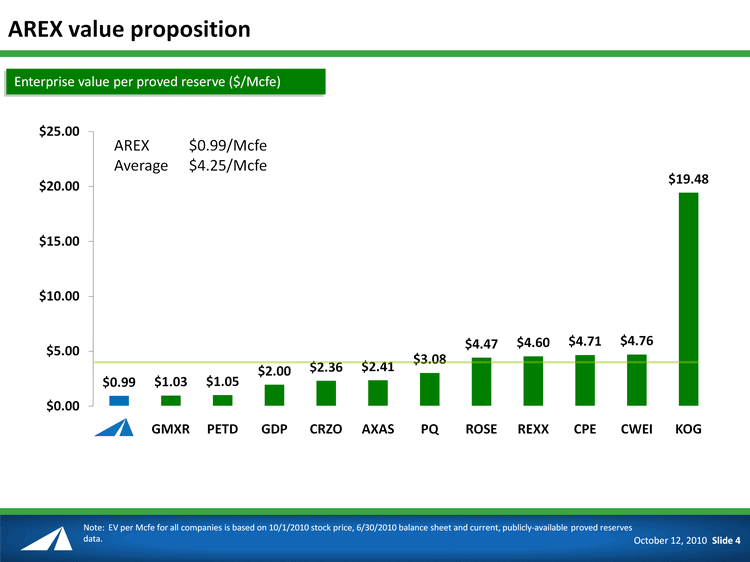
| (CHART) AREX value proposition AREX $0.99/Mcfe Average $4.25/Mcfe October 12, 2010 Slide 4 Note: EV per Mcfe for all companies is based on 10/1/2010 stock price, 6/30/2010 balance sheet and current, publicly-available proved reserves data. Enterprise value per proved reserve ($/Mcfe) |

| (CHART) Production growth 2004 to 2010-E CAGR 36% Production growth (MMcfe/d) Note: 2010-E production based on the midpoint of production guidance, or 9,150 MMcfe. Current production based on 3Q'10 estimated average daily production. October 12, 2010 Slide 5 Average daily production (MMcfe/d) CURRENT PRODUCTION (EST. 3Q'10) |

| (CHART) Reserve growth 2004 to M-Y 2010 CAGR 32% Reserve growth (Bcfe) October 12, 2010 Slide 6 50% Oil & NGLs Proved reserves (Bcfe) |

| Historical performance - at a low cost October 12, 2010 Slide 7 AREX $1.79/Mcfe Average $4.91/Mcfe AREX 596% Average 380% 3-Year average F&D costs ($/Mcfe) 3-Year average production replacement (%) |
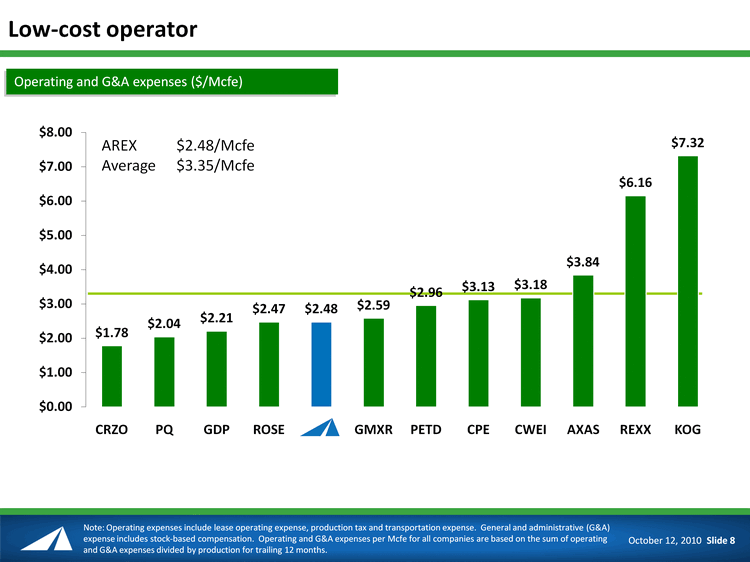
| Low-cost operator AREX $2.48/Mcfe Average $3.35/Mcfe October 12, 2010 Slide 8 Operating and G&A expenses ($/Mcfe) Note: Operating expenses include lease operating expense, production tax and transportation expense. General and administrative (G&A) expense includes stock-based compensation. Operating and G&A expenses per Mcfe for all companies are based on the sum of operating and G&A expenses divided by production for trailing 12 months. (CHART) |

| M-Y 2010 proved reserves highlights October 12, 2010 Slide 9 Reserves highlights Proved reserves increased 27% to 278 Bcfe 95% of proved reserves in the Permian Basin Proved reserves now 50% oil and NGLs and 50% natural gas Oil & NGLs increased 173% to 23 MMBbls Proved developed reserves increased 44% to 134.5 Bcfe Proved reserves now 48% proved developed PV-10 $278 MM |

| Well-balanced reserve mix Reserve mix at December 31, 2009 Reserve mix at June 30, 2010 September 24, 2010 Slide 10 23% Oil & NGLs 77% Natural Gas 43% Proved Developed 57% Proved Undeveloped 48% Proved Developed 52% Proved Undeveloped 50% Oil & NGLs 50% Natural Gas |

| Future outlook: increase oil & NGL production Begin processing natural gas from Ozona Northeast after 1Q 2011 Processing in Ozona Northeast and continued development in Cinco Terry increase oil and NGL production in 2011 and beyond (6:1 conversion) Oil & NGLs as a % of total production October 12, 2010 Slide 11 |

| Permian Basin assets October 12, 2010 Slide 12 Cinco Terry Proved reserves: 76.3 Bcfe Identified locations: 525+ 53% PDP PV-10 $117.0 MM AREX operated with ^52% WI and ^39% NRI Emerging asset with significant growth potential Target formations: Clearfork, Wolfcamp, Canyon Sands and Ellenburger Ozona Northeast Proved reserves: 186.9 Bcfe Identified locations: 650+ 50% PDP PV-10 $159.7 MM AREX operated with ^100% WI and ^80% NRI Legacy asset with significant remaining development potential Target formations: Clearfork, Wolfcamp, Canyon Sands, Strawn and Ellenburger AREX operates 137,495 gross (93,755 net) acres 3-D seismic covers 135,176 acres New acreage connects Ozona NE and Cinco Terry into 93,755 primarily contiguous net acres with multiple pay zones. |

| Permian asset return analysis October 12, 2010 Slide 13 Ozona Northeast - typical Canyon well Cinco Terry - typical Canyon well Average EUR: 500 MMcfe gross EUR Premium price realization: 1,250 Btu per Mcf Wellhead contract Wellhead contract expires after 1Q 2011 ? Begin realizing NGL revenues from liquids-rich gas production Average D&C costs $700k gross Average EUR: 670 MMcfe gross EUR Premium price realization: 1,220 Btu per Mcf Percent of proceeds contract (93%) Average D&C costs $920k gross |
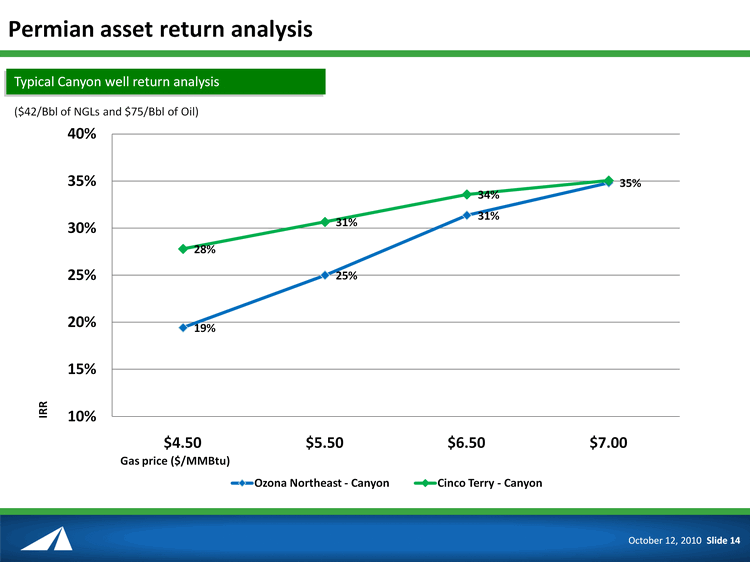
| Permian asset return analysis October 12, 2010 Slide 14 Typical Canyon well return analysis ($42/Bbl of NGLs and $75/Bbl of Oil) (CHART) IRR Gas price ($/MMBtu) |

| (CHART) Permian - Ellenburger upside October 12, 2010 Slide 15 Typical Ellenburger well return analysis ($42/Bbl of NGLs and $75/Bbl of Oil) Compelling upside: 1,500 MMcfe gross EUR Premium price realization: 1,220 Btu per Mcf Percent of proceeds contract (93%) Average D&C costs $730k gross IRR Gas price ($/MMBtu) |
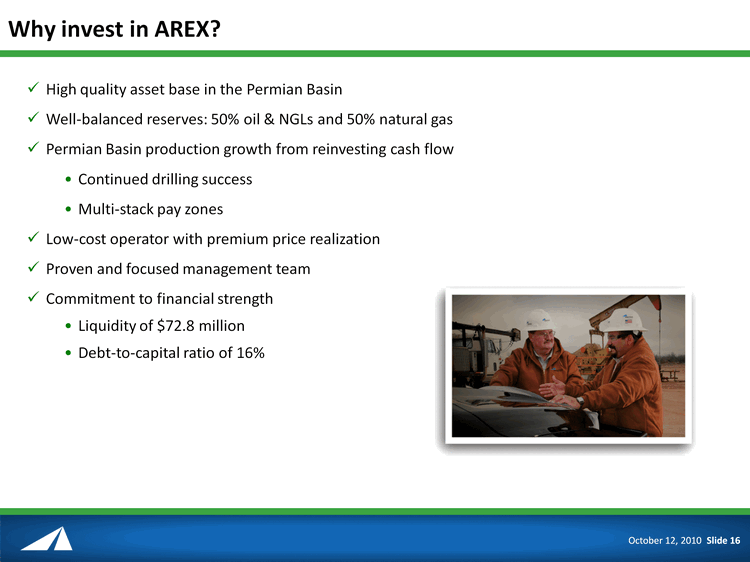
| Why invest in AREX? High quality asset base in the Permian Basin Well-balanced reserves: 50% oil & NGLs and 50% natural gas Permian Basin production growth from reinvesting cash flow Continued drilling success Multi-stack pay zones Low-cost operator with premium price realization Proven and focused management team Commitment to financial strength Liquidity of $72.8 million Debt-to-capital ratio of 16% October 12, 2010 Slide 16 |
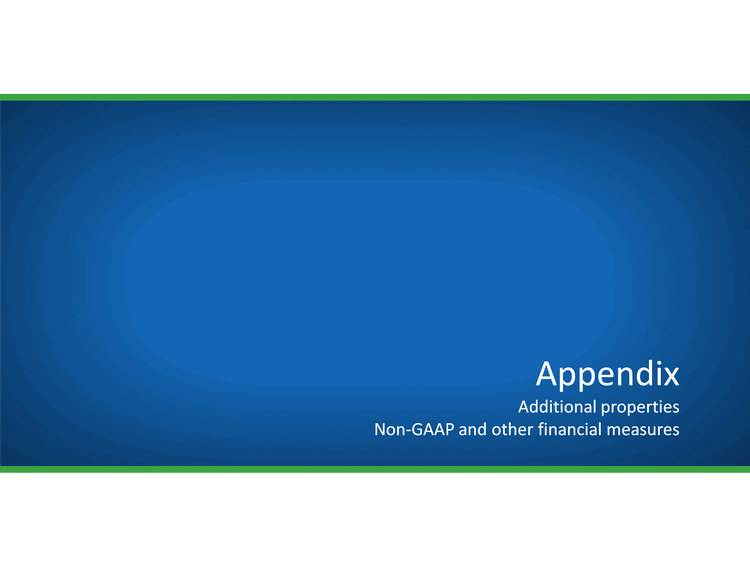
| Appendix Additional properties Non-GAAP and other financial measures |

| North Bald Prairie Proved reserves: 15.1 Bcfe Identified locations: 90+ 7,333 gross (4,487 net) acres AREX operated with ^50% WI and ^40% NRI Cotton Valley Lime and Cotton Valley Sands development Rodessa and Pettit behind pipe potential October 12, 2010 Slide 18 Approximately 2,782 net acres have been re-leased at ^100% WI North Bald Prairie Limestone Co Robertson Co AMI |

| North Bald Prairie - typical Cotton Valley well IRR Analysis (1,300 MMcf gross EUR) October 12, 2010 Slide 19 Average EUR 1,000 to 1,300 MMcfe gross EUR Price realization: 1,050 Btu per Mcf Average D&C costs $2 MM gross IRR Gas price ($/MMBtu) |

| Exploratory plays Northern New Mexico - El Vado East Western Kentucky - Boomerang Mancos Shale/Niobrara exploration 2,000 to 3,000 feet 90,357 gross (79,793 net) undeveloped acres Proximity to several multi-million barrel fields (mostly crude oil) Additional prospectivity in Dakota, Morrison, Todilto and Entrada formations Do not expect to begin drilling in New Mexico until second half of 2011, subject to permitting process New Albany Shale 73,599 gross (43,926 net) undeveloped acres Lease terms (5 year extensions remaining) provide option value on technology and gas prices Two wells previously drilled in the New Albany Shale After evaluating results from test wells, determine development or farm-out program for the prospect October 12, 2010 Slide 20 |

| 2010 Guidance 2010 Financial and operating guidance October 12, 2010 Slide 21 |
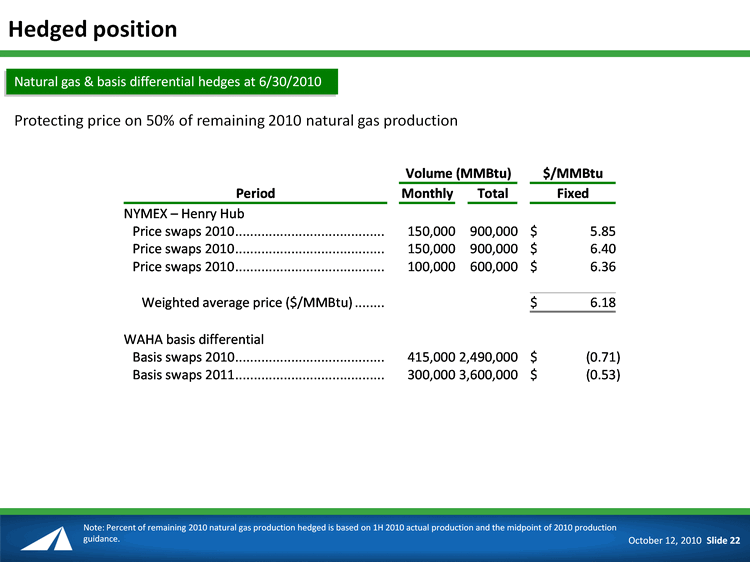
| Hedged position Protecting price on 50% of remaining 2010 natural gas production Natural gas & basis differential hedges at 6/30/2010 October 12, 2010 Slide 22 Note: Percent of remaining 2010 natural gas production hedged is based on 1H 2010 actual production and the midpoint of 2010 production guidance. |

| Equity ownership Equity ownership at 6/30/2010 October 12, 2010 Slide 23 Shares (mm) Percent Management and Affiliates Yorktown Energy Partners 3.8 18 % Lubar Equity Fund, LLC 0.9 4 % Officers, directors and employees 1.7 8 % Subtotal 6.4 30 % Public Float 5% Beneficial owners 1.4 7 % Other stockholders 13.3 63 % Subtotal 14.7 70 % Total 21.1 100 % |

| Capital efficiency AREX 256% Average 135% October 12, 2010 Slide 24 Low-cost operations and high-quality asset base means superior capital efficiency Note: Capital efficiency for all companies is based on trailing 12 months EBITDAX, divided by trailing 12 months production, divided by 3-year average F&D costs. AREX generated $2.56 in EBITDAX for every $1 of capital expenditures. (CHART) |

| Asset intensity AREX 31% Average 108% October 12, 2010 Slide 25 A low asset intensity ratio allows more cash flow for growing production and exploring for and developing upside potential Note: Asset intensity for all companies is based on trailing 12 months production multiplied by 3-year average F&D costs, divided by trailing 12 months cash flow from operations. Best-in-class asset intensity to fund future growth. (CHART) |

| Liquidity and debt-to-capital Liquidity Debt-to-capital Debt-to-capital ratio is calculated as of June 30, 2010, by dividing long-term debt (GAAP) of $42.2 million by the sum of total stockholders' equity (GAAP) and long-term debt (GAAP) of $268.7 million. We use the debt-to-capital ratio as a measurement of our overall financial leverage. However, this ratio has limitations. This ratio can vary from year to year for the Company and can vary among companies based on what is or is not included in the ratio on a company's financial statements. This ratio is provided in addition to, and not as an alternative for, and should be read in conjunction with, the information contained in our financial statements prepared in accordance with GAAP (including the notes), included in our SEC filings and posted on our website. Liquidity is calculated as of June 30, 2010, by adding the net funds available under our revolving credit facility and cash and cash equivalents. We use liquidity as an indicator of the Company's ability to fund development and exploration activities. However, this measurement has limitations. This measurement can vary from year to year for the Company and can vary among companies based on what is or is not included in the measurement on a company's financial statements. This measurement is provided in addition to, and not as an alternative for, and should be read in conjunction with, the information contained in our financial statements prepared in accordance with GAAP (including the notes), included in our SEC filings and posted on our website. October 12, 2010 Slide 26 (in thousands) |

| F&D costs reconciliation (unaudited) October 12, 2010 Slide 27 We believe that providing measures of finding and development, or F&D, cost is useful to assist an evaluation of how much it costs the Company, on a per Mcfe basis, to add proved reserves. However, these measures are provided in addition to, and not as an alternative for, and should be read in conjunction with, the information contained in our financial statements prepared in accordance with GAAP (including the notes), included in our Annual Report on Form 10-K filed with the SEC on March 12, 2010. Due to various factors, including timing differences, F&D costs do not necessarily reflect precisely the costs associated with particular reserves. For example, exploration costs may be recorded in periods before the periods in which related increases in reserves are recorded and development costs may be recorded in periods after the periods in which related increases in reserves are recorded. In addition, changes in commodity prices can affect the magnitude of recorded increases (or decreases) in reserves independent of the related costs of such increases. As a result of the above factors and various factors that could materially affect the timing and amounts of future increases in reserves and the timing and amounts of future costs, including factors disclosed in our filings with the SEC, we cannot assure you that the Company's future F&D costs will not differ materially from those set forth above. Further, the methods we use to calculate F&D costs may differ significantly from methods used by other companies to compute similar measures. As a result, our F&D costs may not be comparable to similar measures provided by other companies. The following table reflects the reconciliation of our estimated finding and development costs to the information required by paragraphs 11 and 21 of ASC 932- 235: |

| F&D costs reconciliation (unaudited) - cont. October 12, 2010 Slide 28 |
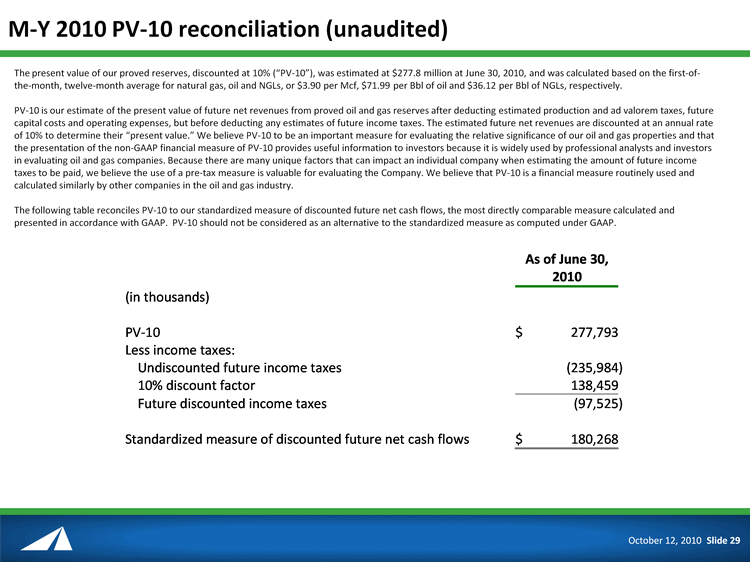
| M-Y 2010 PV-10 reconciliation (unaudited) October 12, 2010 Slide 29 The present value of our proved reserves, discounted at 10% ("PV-10"), was estimated at $277.8 million at June 30, 2010, and was calculated based on the first-of- the-month, twelve-month average for natural gas, oil and NGLs, or $3.90 per Mcf, $71.99 per Bbl of oil and $36.12 per Bbl of NGLs, respectively. PV-10 is our estimate of the present value of future net revenues from proved oil and gas reserves after deducting estimated production and ad valorem taxes, future capital costs and operating expenses, but before deducting any estimates of future income taxes. The estimated future net revenues are discounted at an annual rate of 10% to determine their "present value." We believe PV-10 to be an important measure for evaluating the relative significance of our oil and gas properties and that the presentation of the non-GAAP financial measure of PV-10 provides useful information to investors because it is widely used by professional analysts and investors in evaluating oil and gas companies. Because there are many unique factors that can impact an individual company when estimating the amount of future income taxes to be paid, we believe the use of a pre-tax measure is valuable for evaluating the Company. We believe that PV-10 is a financial measure routinely used and calculated similarly by other companies in the oil and gas industry. The following table reconciles PV-10 to our standardized measure of discounted future net cash flows, the most directly comparable measure calculated and presented in accordance with GAAP. PV-10 should not be considered as an alternative to the standardized measure as computed under GAAP. |

| Contact Megan P. Brown, Investor Relations 817.989.9000 mbrown@approachresources.com www.approachresources.com |
